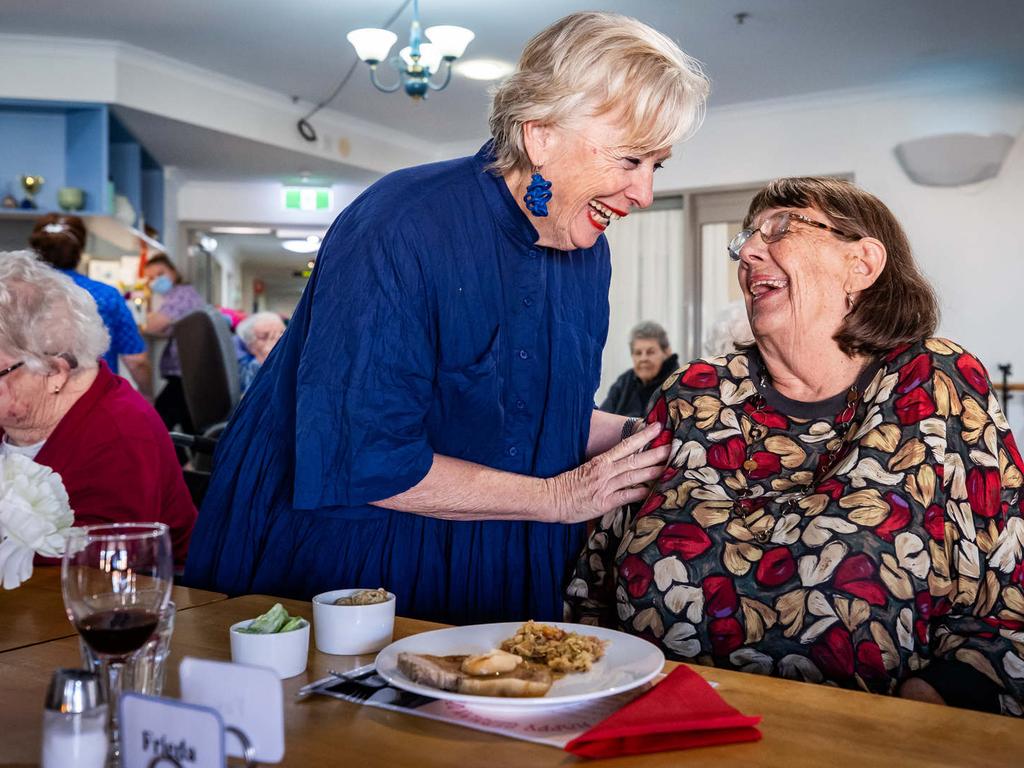Maggie Beer’s mission to fix food in aged care homes
New data has revealed how much money aged care providers are spending on food - with some less than $7 - and how elderly residents rate their meals. See the full list.
National
Don't miss out on the headlines from National. Followed categories will be added to My News.
Exclusive: A Government plan to make aged care more transparent by publishing how much money homes spend on food has spectacularly failed.
Our investigation found the data - for Q1, July to September - was wrong in the majority of cases, rendering the numbers completely useless for people trying to choose a home based on food spend figures.
Providers are legally required to submit accurate numbers, but the Government does not check them.
On the My Aged Care website, one facility, Arcare Point Lonsdale in Victoria, appeared to be spending just four cents on food, per resident, per day. When contacted it revised the numbers up to $12.05.

The reported highest spender on food, two Merindah Lodge homes in Victoria, revised its recorded $63.88 per resident, per day spend down to $25. But when pressed asked us to publish the original figure.
In some cases the figures were out by more than $40.
Blue Care Emerald Avalon Aged Care, west of Rockhampton in Queensland, reported it spent $49.37 on food per resident, per day, but revised it down to $6.11, after we checked. That suddenly made it Queensland’s lowest spender. Only half its residents gave the food a positive review.
The figures were so flawed we decided to check every provider in the bottom 50 and the top 50.
Baptcare – Karana Community in Kew, Victoria, initially confirmed it spent $4.19 per resident, per day, as per “accountancy practices” making it the lowest. Later, it said it was an “accounting error”. It said some of its other homes spent more on bulk buying, with that food shared with other facilities. It said its average spend across its homes was $11.49.

Of those we checked, the top spender in the country was Cohuna District Nursing Home, north of Bendigo in Victoria with $56 per resident, per day.
The lowest in NSW was BaptistCare Warabrook Centre in NSW ($6.70) and its highest RSL ANZAC Village ($47.89).
St Joseph’s House in Port Pirie South Australia was ($7.68), while Disability SA Northgate, spent the most in the state ($33.62).
The Department of Aged Care said it could not check each and every number, but if homes were found to have provided a false figure, that was fraud. Those spending under $10 were referred to the watchdog, which said it considered other risk factors other than spend, including weight loss, complaints and residents’ surveys.
Roald Versteeg from the Aged & Community Care Providers Association said providers supported transparency initiatives, but noted there was an “existing administrative burden already placed on providers”.
The Government said it measured food quality in aged care homes on weight loss and falls.
Overall, over the past two years there was a slight downwards trend in the number of people suffering unplanned weight loss, although there were small increases in the last two quarters.
There have been no long term improvement in falls.

Our analysis of the resident surveys in 2022 and 2023 that positive responses about the food increased from 69.88 per cent to 70.64 per cent, but that almost three in 10 only liked the food sometimes or never.
Dr Morgan Pankhurst from Flinders University from the Food, Enjoy and Satisfaction Team (FEAST) questioned residents, family members and staff about food at more than 100 homes across the country.
Overall around 60 per cent of residents were happy with the food, but family members were overwhelmingly unhappy, with one commenting, “my dog eats healthier food”.
Dietitians Australia President Tara Diversi said while targeted reforms were underway, it would take time for food and nutrition standards to lift.
She wants malnutrition screening to be introduced, to help spot at-risk residents more quickly.
Accredited Practising Dietitian Karly Bartrim said the food being served in many homes was still unacceptable.
“We’re still seeing residents served cold, unrecognisable food,” she said.
Minister for Aged Care, Anika Wells said the Government was “committed to increasing transparency over public dollars going into aged care”.
She said the new transparency tool and star ratings on My Aged Care website would hold providers to greater account for how they spend taxpayer money.
“We’re also investing $3 million for up to 1000 menu and mealtime assessments over two years for aged care providers to be completed by independent Accredited Practising Dietitians – a measure which Dietitians Australia has applauded as “the start of the end of malnutrition in aged care in this country,” Minister Wells said.

MAGGIE BEER’S MISSION
Five million dollars and a celebrity chef.
That was Labor’s big election pledge to improve on the cheap party pies and slop being served in some aged care homes across the country.
Beloved icon Maggie Beer, who has long advocated for better, healthier and tastier food for older people in aged care facilities, was tasked with the job of improving meals.
The Maggie Beer Foundation runs a one-on-one trainer-mentor program which has so far reached 84 cooks and chefs in 50 aged care homes, and will benefit 4200 aged care residents across Australia.
The target is 120 homes by next year.
A second program, free virtual hubs offering online training has reached 279 cooks and chefs from 196 homes, benefiting 9800 residents. The course consists of three online sessions, chefs only have to attend two to pass.

There are 2700 homes across the country.
The average daily spend on food per aged care resident is $13.68, according to Beer.
“The budget is never enough but anyone doing less than that is not doing good enough food,” Beer said.
This month she was in South Australia’s Barossa Valley checking on chefs who have been through her upskilling program.
The menu at Barossa Village, in Nuriootpa – which spends $16.74 a day per resident on food – featured traditional German-themed menu and included dishes such as slow roasted pork with apple sauce, potato salad, cucumber salad, sweet and sour cabbage and a streusel for dessert, with crumble topping, quince and runny custard.

“I have physically been in three homes – one in Melbourne, Sydney and here – and you can see a change in the residents’ pleasure,” Beer said. “If the resident is eating with gusto then you know that you have done what you need to do. That’s what keeps you going.”
It’s probably too soon to judge whether the programs are having any real impact across the sector.
So, for the time being we can only go on the satisfied smiles of residents in Barossa Valley.
Fay Reese, 79, said she’d put on a “lot of weight” since moving to the home last year.
“I love good food, it’s so important because they’re nothing much to live for otherwise,” she said.
More Coverage
Originally published as Maggie Beer’s mission to fix food in aged care homes







